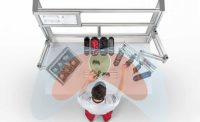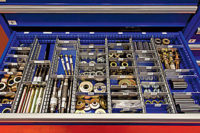Workstations and Lean
Lean manufacturing is known by a number of names: agile manufacturing, cellular manufacturing, and just-in-time manufacturing. However, all these variants were born of the Toyota Production System. Regardless of what your company calls it, all variants share the same goal-eliminate waste in all aspects of the manufacturing process.
By focusing on the customer's specific need and not on "production for production's sake," lean manufacturing asks the question, "Are we doing things that the customer will not pay for, and how can we stop doing those things?" The premise is simple. Customers have no interest in paying for waste of any kind. This includes rework, inventory, excessive setup or production times, inefficient use of space and product transportation.
Organizations that fully adopt lean manufacturing principles can assemble products economically in lower volumes and get them to market faster. In some cases, lean manufacturers can double production at similar or better quality levels using half the time and space, at half the cost, with greatly reduced inventory.
The following nine principles represent the core elements of all lean manufacturing programs:
• lean equipment,
• elimination of waste,
• flexibility,
• visual factories,
• error proofing,
• point of use storage,
• setup reduction,
• workplace organization,
• just-in-time production.
What does lean manufacturing have to do with workstations? Even in today's automated environment, skilled workers continue to dominate the shop floor, from material preparation through product shipment. Because assembly tasks and processes are changing with increasing frequency, people and the work they perform at workstations will continue to be critical in a wide variety of manufacturing operations.
When selecting workstations for lean manufacturing environments, the entire use cycle should be considered. The workstation use cycle consists of three phases: the initial installation; adjustment during use; and reconfiguration of individual workstations and the entire facility layout. Lean principles may be applied in all three of these phases.
Lean Principles and Workstation Features
Lean equipment. Workstations must be thought of as production equipment, and not as "furniture." "Lean equipment" is an umbrella term that may be applied to equipment that exhibits characteristics such as quick changeover, minimal or no maintenance, and error-proof setups. To determine if a workstation may be considered "lean," evaluate it in terms of each of these categories. How quickly can changeover be accomplished? What maintenance does the system require and how often? How easily can an operator make an error when setting up or using the workstation?
Elimination of waste. Workstation layouts should be expandable at low cost and with minimal purchases of extra parts. For example, when converting from a single-sided workstation to a double-sided workstation, or from a stand-alone unit to an inline unit, consider the incremental cost for any additional parts that might be required. Ask which existing parts will not be usable in the new layout. Incremental costs for these conversions can vary dramatically depending on the workstation design.
Manufacturers can save substantial floor space with the right workstation design and layout. By making the most effective use of vertical space above and below the work surface, the area of the work surface can be reduced and the footprint of the workstation decreased, sometimes as much as 30 percent. Consider the space used by the workstation's structural components, such as columns and frames. Look for workstations with small, high-strength structures so that work surface area can be maximized within the workstation envelope and not unduly affected by the intrusion of columns or other structural members.
Flexibility is the ability to adjust easily to change. This applies to changes at the individual workstation, as well as changes in the process flow or facility layout. Modular systems are inherently more flexible than stand-alone units in this regard. Modular systems are characterized by the sharing of structural components and the ability to create different layouts, such as inline, C, X, U or L layouts.
If workstations are truly flexible, assemblers should be able to quickly and easily convert them from one layout to another. There are great differences between workstations in how easily and economically layouts can be changed.
Visual factories, visual management or management by eye refer to the ability to quickly assess the state of production activity simply by looking around. Clear lines of sight and use of color are two important concerns.
Clear lines of sight are important for spotting production bottlenecks, operator movements, parts shortages and floor inventory issues. Workstations need to have slim structural profiles and minimal visual obstacles that interfere with observations.
Color may be used to identify processes, departments or product lines. The ability to add or change color accents on workstations enables managers to use color for these purposes.
Error proofing. Specific instructions are typically provided for setting up workstations based on the task, product or tools to be used. Diagrams may be used showing locations of essential tools and materials. Setup personnel must be able to set up workstations with minimal opportunity to make errors.
During setups, accurate assembly, placement and leveling of system components are best achieved when no tools or hardware are required, and when the components can be attached to the system in predefined locations by means of a positive, locking connection. This eliminates the need for leveling or calibration, and it reduces the potential for incorrectly assembling attachment hardware. Eliminating the need for tools also prevents use of an incorrect tool, such as a damaged screwdriver or oversized wrench. At best, this could damage workstation hardware. At worst, it could result in an injury if the hardware is not correctly fastened.
Point of use storage. On the factory floor, "supermarkets" are mini storage areas for tools and materials. They contain just enough parts to maintain production, but without any excess. Materials should be located as close to their point of incorporation in the product as possible, typically at the workstation itself.
To support this concept, workstation systems may incorporate part bin boards, carousels, storage areas, transport carts, off-line parts kitting modules and flow-rack modules. Workstation systems should enable users to configure parts racks, mobile parts carts and flow-racks using interchangeable components. This not only facilitates the creation of supermarkets, but it further contributes to the overall agility of the equipment on the factory floor. For example, if a mobile parts cart shares the same parts storage accessories as the workstation, parts can be easily transferred between the cart and the workstation.
Setup reduction. As product variety increases and lot sizes decrease, workers will need to create new setups at their workstations more frequently. To optimize production efficiencies, operators must be encouraged to adjust their workstations.
They should find this easy to accomplish, preferably without the need to involve other people. Adjustments such as changing the height or angle of shelves; adding or relocating tool and equipment holders; positioning materials on the workstation for easy access; and adjusting lighting are most easily accomplished when no tools are required and components are lightweight.
In multishift operations, workers on different shifts need to be able to adjust their workstations to accommodate their physical attributes.
Workplace organization. Organizing a work area to maximize efficiency is essential for cycle time reduction and process control. Tools and materials should be arranged near the operator according to frequency of use, and they should always be returned to designated tool holders or storage areas.
The ability to fully utilize the vertical space available at the workstation is critical to effective workplace organization. This includes space above and also below the work surface, which is often overlooked. For example, shelving installed below the work surface can be an excellent place to store tools, fixtures or materials that are seldom used.
Maximize use of vertical space by selecting workstations that take the most advantage of the space above the factory floor. The average male can reach to 7.5 feet when standing, and the workstation should make full use of this reach envelope. Items used less frequently can be positioned further from the operator, often on swing arms, moveable platforms, or shelves to bring the items within the reach envelope when needed. Engineers should be able to locate drawers at any position beneath the work surface-right, left or center-to accommodate all possibilities for best positioning.
Workstation manufacturers that offer a wide range of storage options, such as tool holders, material bins, drawer units and shelves in a variety of depths, will be better able to support workplace organization. Orderliness results in minimum waste of human energy, while contributing to effective inventory management at the workstation.
Just-in-time production requires that only the needed number of units be produced on demand. This results in smaller lot sizes and greater product variety. Workstations must be easily reconfigured and set up so that producing small lot sizes-even a lot size of one-is practical and affordable.
In addition, the workstation should be compatible with off-line kitting practices and parts delivery methods. Examples include a parts or kit cart that can be rolled up to and "plugged in" to the workstation, or an off-line parts bin holder that can be kitted with parts and attached to a swing arm for presentation to the operator.
As tools of production, workstations are important elements of a lean manufacturing system. Lean manufacturing focuses on eliminating waste, which can typically be categorized as overproduction, excessive waiting times, excessive transportation of product or materials during assembly, and wasted motion at the workstation.
Correctly designed and configured workstations can make a significant impact on reducing waste in all these areas. Workstation manufacturers should be able to provide consulting services, application-specific equipment, and graphical simulations of proposed lines for customers pursuing lean manufacturing to ensure that the workstations contribute to the overall goals of the manufacturing enterprise.
For more information, call Arlink 888-559-4441 or visit www.arlink.com.
Looking for a reprint of this article?
From high-res PDFs to custom plaques, order your copy today!





